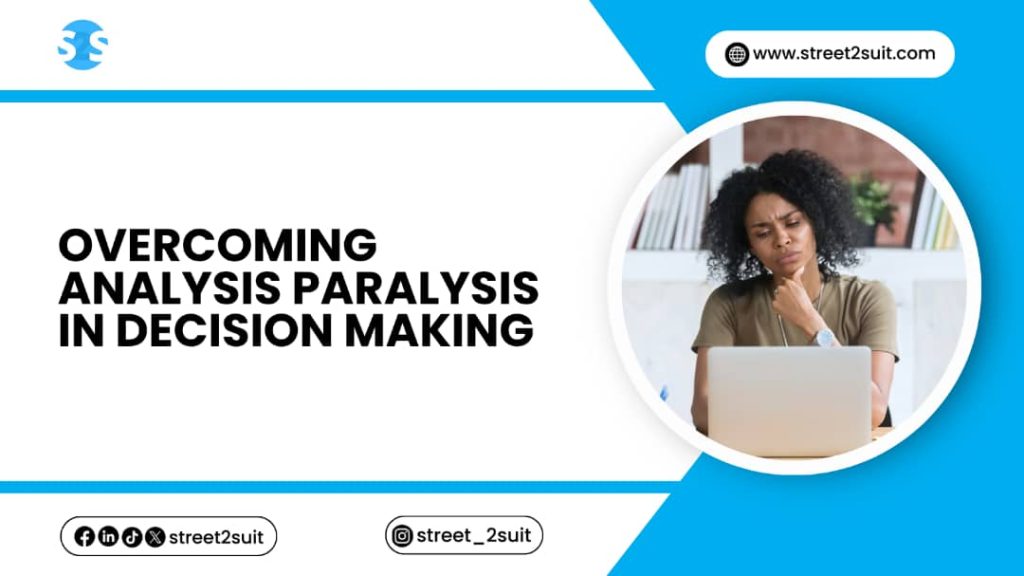You’ve got 37 tabs open, three spreadsheets running comparisons, a half-written pros/cons list, a project with a looming deadline, and a friend group chat you don’t want to miss out on. Hours later… no decision. Sound familiar? Well, that’s analysis paralysis – that frustrating state where too much thinking leads to exactly zero doing.
What Is Analysis Paralysis?
Analysis paralysis happens when the effort to make the best decision becomes the reason no decision gets made at all. We over-research, over-model, over-compare, and under-act. You think you’re being thorough but in reality, you’re stuck in a loop of diminishing returns.
Whether you’re choosing a project management platform, deciding on a career move, or just trying to pick a restaurant that will satisfy your cravings, analysis paralysis can stall progress, drain energy, and cost real opportunities.
You really want to stop circling the runway and actually land the plane. You can break the loop with structure, mindset shifts, and a few practical tools. You can move from “What if…” to “Let’s go.”
Relax your nerve and let’s walks through why analysis paralysis happens, how to recognize it, and strategies to make confident, timely decisions without feeling reckless.
Common Signs You’re Stuck
- You keep gathering “just one more” data point. Then another.
- Your options list grows, but none get eliminated.
- You reopen decisions you supposedly made.
- Deadlines slip because “the decision isn’t ready.”
- You feel anxious, guilty, or mentally exhausted, yet still uncertain.
If progress is stalled and clarity isn’t improving, you’re not deciding—you’re spinning.
Why Analysis Paralysis Happens
You’re not bad at deciding. Your brain is reacting very normally to messy, high-stakes situations. Here are the usual suspects:
Choice Overload: Too many options make comparisons cognitively expensive.
Perfectionism: You want the optimal choice and fear anything less.
Loss Aversion: Potential loss looms larger than potential gain, so inaction feels safer.
Fear of Regret: “What if I choose wrong and future-me hates me?”
Social Evaluation: Stakeholders, bosses, or peers are watching; reputation risk grows.
Ambiguity: Incomplete or conflicting data keeps you from feeling ready. Recognizing the root helps you choose the right antidote.
The Hidden Cost of Not Deciding
Indecision often feels safer than action but it rarely is.
- Opportunity Cost: While you stall, options expire, competitors move, and windows close.
- Decision Debt: Delayed choices pile up and eventually force rushed calls.
- Team Drag: If you lead others, hesitation kills momentum and morale.
- Emotional Burn: Lingering uncertainty is mentally exhausting, bandwidth shrinks for good thinking.
Making a good-enough decision on time often beats a perfect one made too late.
Not All Choices Deserve Equal Analysis
One reason we get stuck is, we treat every decision like it’s life or death. Try sorting decisions into categories by reversibility and impact. Ask yourself if this goes wrong, can we recover? If yes, stop over-analyzing, ship it and learn.
The Diminishing Returns Rule
At some point, gathering more data doesn’t improve the decision, it just delays it. A helpful heuristic used by many effective leaders: decide when you’re ~70% informed. Waiting for 100% certainty is fantasy or hindsight.
Pair that with a decision deadline: “We will select a vendor by the 15th, using data gathered to date.” Constraints build focus; unlimited time breeds paralysis.
A Simple Framework: D.E.C.I.D.E.
Use this repeatable mini-process to move from stuck to done:
D – Define the decision. What exactly must be chosen? Avoid decision drift.
E – Establish success criteria. What must this decision accomplish? List 3–5 measurable or observable outcomes.
C – Collect bounded data. Decide in advance what info you need—and stop when you have it.
I – Identify options & tradeoffs. Narrow to 3 strong candidates. Drop the rest.
D – Decide by deadline. Use your criteria, not mood. If tie: pick the option that preserves flexibility.
E – Evaluate later. Set a review date. You don’t need perfect—just direction + a feedback loop.
Clarify What Really Matters
When everything is important, nothing is prioritized, and paralysis follows. Split criteria into:
- Non-Negotiables (Musts): If a choice doesn’t meet these, it’s out.
- Value Add (Wants): Bonus points; break ties.
Example (choosing a learning platform):
Musts: Mobile access, progress tracking, exportable reports.
Wants: Built-in gamification, custom branding, live chat.
Quick filter = faster shortlist = less overthinking.
Use Lightweight Scoring to Compare Options
If you need structure, try a simple weighted scorecard:
List your criteria (max 6–8).
Assign weights (total = 100%).
Score each option 1–5 per criterion.
Multiply, add, compare.
Don’t obsess over decimal precision. The benefit isn’t mathematical accuracy—it’s clarity.
Emotional Tools That Get You Unstuck
Sometimes the data is clear but feelings keep you frozen. Try these mental shifts:
The 10-10-10 Test
How will you feel about this decision in 10 days? 10 months? 10 years? Suddenly, small fears shrink.
Worst-Case / Repair Plan. Write the worst realistic outcome and how you’d recover. If recovery is doable, fear loses its grip.
Pre-Mortem: Imagine the decision failed spectacularly. What caused it? Now proactively guard against those causes.
Friend Test: What would you advise a friend in the same spot? We’re kinder and clearer when emotions aren’t in the way.
Build Decision Momentum with Micro-Decisions
If you freeze on big calls, practice with small, low-risk choices. Pick a template and ship the draft, choose one course to start instead of evaluating 20, give team members autonomy on small deliverables. Confidence grows with reps. Make deciding a habit, not a high-drama event.
Prevent Group Analysis Paralysis
Teams are fertile ground for decision drift. Use these leadership practices:
- Name a Decision Owner. Discussion is shared; decision isn’t.
- Time-Box Discussion Phases: “Data collection ends Wednesday.”
- Use RACI or DACI Roles: Who approves? Who must be consulted?
- Disagree & Commit: Debate now; once decided, everyone supports execution.
- Document the ‘Why.’ Reduces re-litigation and future second-guessing.
When You Should Slow Down
Not every stall is paralysis, sometimes it’s prudence. Pause if legal, safety, or compliance risks are unclear. If the decision is expensive and irreversible, critical data is expected imminently. Stakeholder alignment is required to execute. The trick is differentiating “We need real input” from “I’m scared to choose.” Check yourself.
Create a Personal Decision Playbook
If you face recurring decision overwhelm, formalize your approach:
My Triggers: (e.g., too many tools to compare, fear of regret.)
My Fast Filters: Must-have criteria, budget caps, reversibility check.
Deadline Rule: No research more than X hours without narrowing.
Review Habit: Log decisions + outcomes in a “decision journal” for future pattern spotting.
The more you systematize, the less each decision drains you.
Quick Rescue Checklist
Ask yourself:
- Have I defined the decision clearly?
- Do I know my top 3–5 success criteria?
- Have I limited my options to 3 or fewer?
- Is this decision reversible? (If yes, decide now.)
- Do I have “enough” info (~70%) to move?
- Have I set a decision deadline?
If you answered “yes” to most—make the call.
Conclusion
You don’t overcome analysis paralysis by thinking harder, you overcome it by deciding smarter. Most progress in work and life comes from iterating, not nailing perfection on the first try. Decisions are rarely permanent verdicts; they’re experiments with learning attached.
So next time you feel stuck between Option A, B, and panic research, remind yourself to choose, act, review, adjust. Clarity lives on the far side of motion. Close the extra tabs. Pick a direction. Learn as you go. You’ve got this. And if you don’t? You’ll learn, and that is forward.
Receive the latest job and career updates in your inbox, every week!
Mariam is an imaginative and meticulous writer who is passionate about crafting compelling narratives and translating concepts into influential content.



